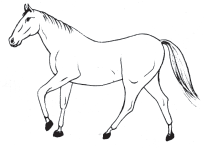HUMAN AND ANIMAL FIGURES
INTRODUCTION
We see innumerable living beings roaming on earth, water, and in the air. They are either male or female. Consequently, they are physiologically different.
On close observation, we find beauty, delicacy, beautiful body shape, and flexibility in the physique of every living being. The structure of every living being is proportionate. This facilitates normal movement and their ability to perform their routine easily.
Man is the best of all living beings. That’s why man has superior emotions. The artist also expresses those super emotions through his paintings.
Students of art should keep all these facts in mind while exercising paintings.
Our world is full of living creatures of different types. Some stand on their two legs, some on four legs. Few of them can fly and some can swim in the water. So, an artist should be acquainted with the lives of these creatures and should learn to capture them in lines and colors. The most interesting of them are humans, animals, and birds.
- get the required information about the structure, measurement, and proportion of the living beings;
- draw simple sketches with lines;
- sketch human and animal figures;
- draw the human structure of any measurement.
Materials to be used
- Cartridge paper or newsprint paper sketchbook.
- H.B. pencil for fine and hard lines, 2B and 4B pencil for softer fluent lines with different thicknesses.
- 6B pencil for dark tones.
- Eraser
|
Human Structure, Measurement, and proportion |
|
|
Fig. 1 |
•
Generally body structures keep on changing through the process of age. •
For example, a young man’s
measurement, proportion, and structure of
the body could be divided into 7½ units.
(see the figure) head to chin 1 unit, into chest 2nd unit, chest to naval 3rd unit, naval to crotch 4th unit,
crotch to knee 5th unit,
knee to middle of the lower the lower-leg 6th unit and from therefrom thereto ankle
7th unit. Feet should be of ½
unit. |
|
Straight Line Sketching |
|
|
Fig. 2 |
•
Straight line sketching is very important to understand the structure and movement of the body. •
It also helps to understand the proportion of the figure which later could be developed into a complete sketch with volume. |
|
Free
Hand Sketching |
|
|
Fig. 3 |
•
To sketch from any live model is very important because it helps to capture the movement characteristics of the model (could be human or animal figures). • Straight line sketch would help directly without any
predetermined structure drawing. |
|
Difference between the
Human and Animal Figures |
|
|
|
•
The general difference between human and animal figures is that human figure
is mainly vertical while animal figures are horizontal. •
The artist has to be very fast to sketch an animal figure because these creatures do not pose as models like
human beings. •
Human figures mostly follow a set of rules of proportion and measurement. •
Animals, birds, and different species have a different set of rules of proportion and
measurements because of their different body structure. •
Lot of practice can only enhance the skill. |

![]()
|
Let us learn the steps of animal figure drawing |
|
|
Fig. 1 |
Drawing of a Horse STEP 1 •
Draw two circles in the proportionate distance for the back and frontal part of the body. •
Join the two circles to draw the back of the horse. • Add four lines for legs. •
Add a triangle for the head and a rhythmic line for the tail. |
|
Fig. 2 |
STEP-2 • Give volume to the skeleton by adding lines around the straight-line drawing. |
|
|
STEP-3 •
Finish the drawing using outlines for the
different parts of the body. •
Remove all the skeleton drawings and drawings and unnecessary lines. •
Add a few lines to give proper details to the figure. |

![]()
|
STEPS TO DRAW
HUMAN FIGURE FROM STRAIGHT-LINE SKETCH |
|
|
Fig. 1 |
STEP 1 •
Choose a composition of Dandiya dance with two human figures. •
Draw two figures in simple straight lines as the skeleton of the two dancing figures. |
|
Fig. 2 |
STEP 2 •
Give volumes by adding lines on the torso of the figures. |
|
Fig. 3 |
STEP 3 •
Now add more lines to complete the human figures considering the characteristics of a boy and girl. |






















0 Comments